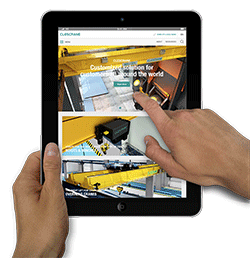Related Introduction on Rail Installation (2)
4. Technical requirements on rail installation
1) Prior to the rail laying, the rail end face, straightness and distortion should be checked until deemed Pass.
2) The rail installation baseline should be determined prior to the rail lifting. A good rail installation baseline should be the positioning axis of the crane beam.
3) The positional deviation of the actual rail center line from the actual crane beam center line should be no more than 10mm and be no more than the half thickness of crane beam plate.
4) For the general overhead crane, general gantry crane and handling bridge, the deviation of the actual rail center line from the installation baseline should be no more than 5mm. For the beam suspension crane, the deviation should be no more than 3mm.
5) When the crane rail span is no more than 10m, the allowable deviation of the crane rail span should be ±3mm.
6) When the crane rail span is more than 10m, the allowable deviation of the crane rail span should be calculated using the formula below but should be no more than ±15mm.
△S=±[3+0.25(S-10)]
where △S——allowable deviation of the crane rail span(mm);
S——crane rail span(m)
7) For the general overhead crane, the longitudinal inclination of the rail top from the designed position should be no more than 1/1000. For the general gantry crane, the longitudinal inclination should be no more than 3/1000. The measurement should be done at the interval of every two meters and the height difference of the full travel should be no more than 10mm.
8) For the general overhead crane, general gantry crane and handling bridge, the allowable deviation of the elevation of the rail top datum point from the designed elevation should be ±10mm. For the beam suspension crane, the allowable deviation should be ±5mm.
9) For the general overhead crane, general gantry crane and handling bridge, the relative elevation difference of two parallel rails in the same section should be no more than 10mm. For the beam suspension crane, the relative elevation difference should be no more than 5mm.
10) For the horizontal directional crane, its rail bending in the horizontal plane along the length direction in every two meters of measured length should be ±1mm.
11)The positions of two parallel rail joints should stagger, of which the distance should not equal the base distance of the crane front and rear wheels.
5. Rail joints should meet the following requirements:
1) When the joints are butt welded, the welding rod should meet the requirements on the rail base material and the welding quality should comply with relevant electric welding regulations. The joint top and the lateral weld should be both polished flat and smooth.
2) When the joints are connected with fish plate, the height difference of rail joints and lateral displacement should be no more than 1mm and the clearance should be no more than 2mm.
3) The clearance at the expansion joint should be consistent with the design rules, of which the allowable deviation should be ±1mm.
4) For square steel rail supported with backing plate, the width of the backing plate at the joint (along the rail length direction) should be one time larger than other places
5) The allowable deviation of the distance between two rails under the same support of the general gantry crane and handling bridge should be ±2mm and the relative elevation difference should be no more than 1mm.
6) The concrete grouting layer or the leveling layer between the concrete crane beam and the rail should be consistent with the design rules.
7) When the resilient sleeper bearing is used under the steel rail as bed course, its specifications and material should be consistent with the design rules. The steel rail should be close to the resilient sleeper bearing before the bolts are fastened. When there is clearance between them, the backing plate should be fitted under the resilient sleeper bearing. The backing plate should be 10-20mm longer or wider than the resilient sleeper bearing.
8) When the steel rail is laid on the steel crane beam, the steel rail bottom should be close to the steel crane beam top. If there is clearance and its length is more than 200mm, a backing plate should be fitted in, of which the length should be more than 100mm and the width should be 10-20mm more than that of the rail bottom. Each set of backing plates should be no more than three layers, which should be welded firmly together with the steel beam after being fitted in.
9) The lateral inclination of square steel and I beam should be no more than 1/100.
10) After the rail meets requirements after adjustment, all the bolts should be re-checked to ensure no looseness.
11) The rail car stop should be installed in front of the lifting crane. Car stops on two rails of the same cross end should be both in contact with the crane buffer.










